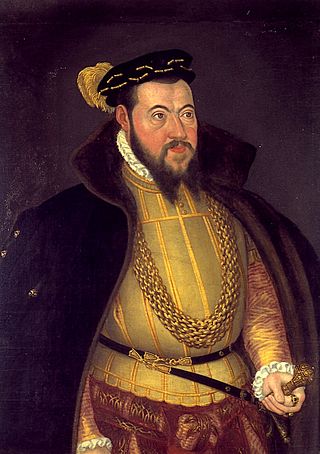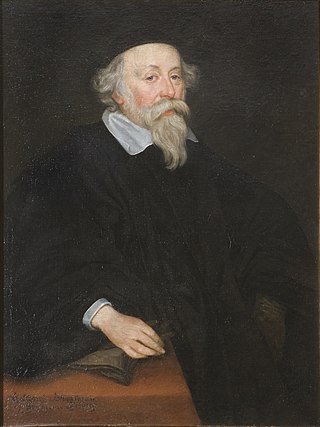
The House of Wittelsbach is a former Bavarian dynasty, with branches that have ruled over territories including the Electorate of Bavaria, the Electoral Palatinate, the Electorate of Cologne, Holland, Zeeland, Sweden, Denmark, Norway, Hungary, Bohemia, and Greece. Their ancestral lands of Bavaria and the Palatinate were prince-electorates, and the family had three of its members elected emperors and kings of the Holy Roman Empire. They ruled over the Kingdom of Bavaria which was created in 1805 and continued to exist until 1918.

Zweibrücken is a town in Rhineland-Palatinate, Germany, on the Schwarzbach river.

Catherine of Sweden was a Swedish princess and a Countess Palatine of Zweibrücken as the consort of her second cousin John Casimir of Palatinate-Zweibrücken. She is known as the periodical foster-mother of Queen Christina of Sweden and the mother of Charles X of Sweden.

The House of Palatinate-Zweibrücken, a branch of the Wittelsbach dynasty, was the ruling dynasty of Sweden from 1654 to 1720.

The Duchy of Palatinate-Zweibrücken was a duchy of the Holy Roman Empire with full voting rights to the Reichstag. Its capital was Zweibrücken. The reigning house, a branch of the Wittelsbach dynasty, was also the Royal House of Sweden from 1654 to 1720.

The County Palatine of Veldenz was a principality in the contemporary Land Rhineland-Palatinate with full voting rights to the Reichstag. The county was located partially between Kaiserslautern, Sponheim and Zweibrücken, partially on the Mosel in the Archbishopric of Trier. A municipality of the same name, Veldenz, and a castle, Schloss Veldenz, are located in the district of Bernkastel-Wittlich.

Count Palatine Wolfgang of Zweibrücken was member of the Wittelsbach family of the Counts Palatine and Duke of Zweibrücken from 1532. With the support of his regent, his uncle Rupert, Wolfgang introduced the Reformation to Zweibrücken in 1537.

John I of Zweibrücken was Count Palatine and Duke of Zweibrücken during 1569–1604.

Count Palatine Gustav Samuel Leopold of the House of Wittelsbach was the Count Palatine of Kleeburg from 1701 until 1731 and the Duke of Zweibrücken from 1718 until 1731. His titles included: 5th Duke of Stegeborg, Count Palatine of the Rhine, and Duke in Bavaria.

La Petite-Pierre is a commune in the Bas-Rhin department in Grand Est in north-eastern France. It lies in the historical and cultural region of Alsace. Petit-Pierre literally means little rock.

John Casimir, Count Palatine of Zweibrücken-Kleeburg was the son of John I, Count Palatine of Zweibrücken and his wife, Duchess Magdalene of Jülich-Cleves-Berg. He was married to Catherine of Sweden and was the founder of a branch of Wittelsbach Counts Palatine often called the Swedish line, because it gave rise to three subsequent kings of Sweden, but more commonly known as the Kleeburg line.

The House of Palatinate-Birkenfeld, later Palatinate-Zweibrücken-Birkenfeld, was the name of a collateral line of the Palatine Wittelsbachs. The Counts Palatine from this line initially ruled over only a relatively unimportant territory, namely the Palatine share of the Rear County of Sponheim; however, their importance steadily grew. All living members of the House of Wittelsbach descend from Palatinate-Birkenfeld, which thus became the parent branch of the Kings of Bavaria.
Palatinate-Sulzbach was the name of two separate states of the Holy Roman Empire located in modern Amberg-Sulzbach, Bavaria, Germany, ruled by a branch of the House of Wittelsbach.

Adolph John I was Count Palatine of Kleeburg from 1654 until 1689 and was considered Prince of Sweden until 1660. He was the younger brother of King Charles X Gustav of Sweden.

Palatinate-Lützelstein was an ephemeral state of the Holy Roman Empire based around La Petite-Pierre, located in the Vosges Mountains, in the present-day Bas-Rhin and Moselle départements of the Grand Est region in northeastern France.

Leopold Louis was the Count of Veldenz from 1634 until 1694.

Duchess Magdalene of Jülich-Cleves-Berg was the fifth child of Duke William "the Rich" of Jülich-Cleves-Berg and Maria of Austria, a daughter of Emperor Ferdinand I.
Catherine of Pfalz-Zweibrücken, was the daughter of Adolph John I, Count Palatine of Kleeburg and Countess Elsa Elisabeth Brahe of Wisingsborg, cousin of Charles XI of Sweden and the sister of Adolph John II, Count Palatine of Kleeburg and Gustav, Duke of Zweibrücken. She is foremost known for the scandal involving herself and her siblings, when she, after a long ongoing conflict in 1686-88, escaped from the authority of her parents.
Maria Elizabeth of Pfalz-Zweibrücken, was the daughter of Adolph John I, Count Palatine of Kleeburg and Elsa Elisabeth Brahe af Wisingsborg, cousin of Charles XI of Sweden and the sister of Adolph John II, Count Palatine of Kleeburg and Gustav, Duke of Zweibrücken. She is foremost known for the scandal involving herself and her siblings, when she, after a long going conflict in 1686-88, eloped from the authority of her parents.

Elsa Elisabeth Brahe, was a Swedish countess and duchess, married to Adolph John I, Count Palatine of Kleeburg, Duke of Stegeborg, the brother of king Charles X of Sweden.
















